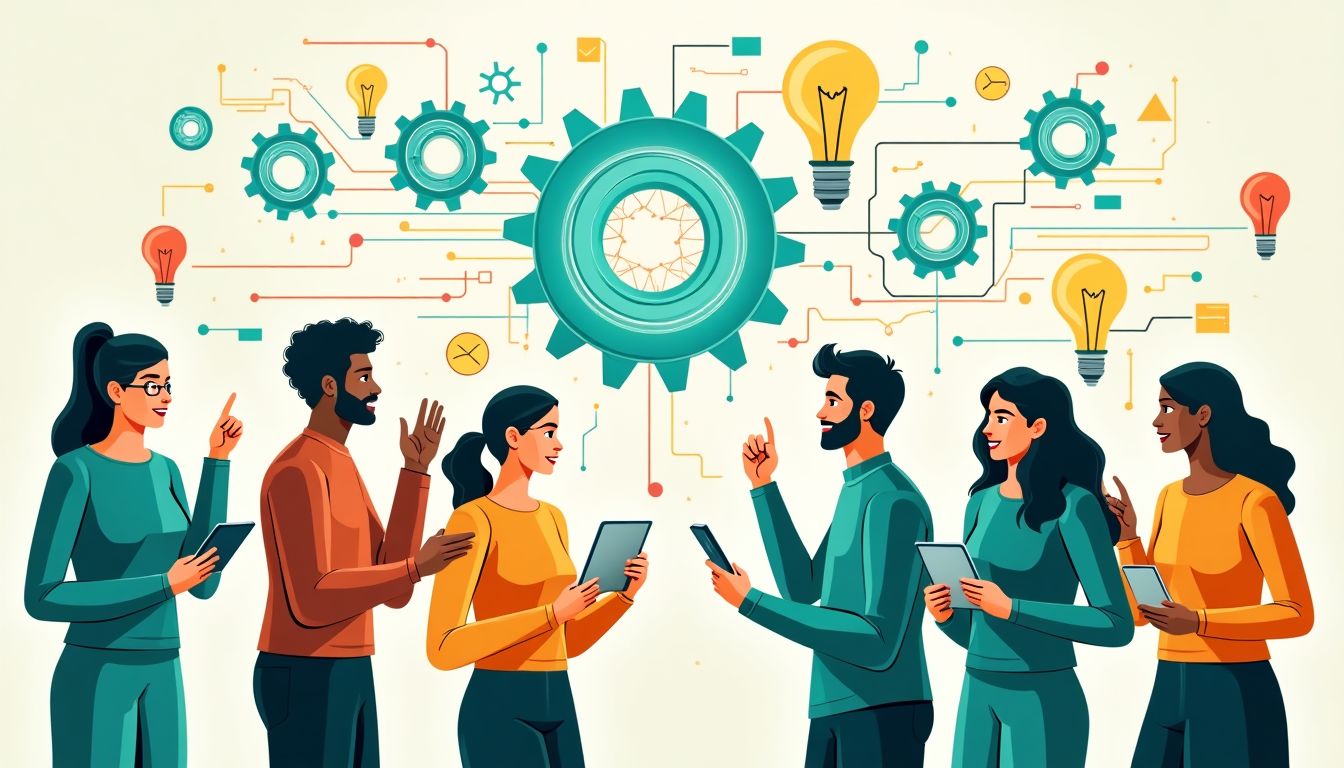Introduction: A New Era of Innovation
The secret of change is to focus all of your energy, not on fighting the old, but on building the new. – Socrates This thought-provoking quote perfectly encapsulates the dawn of an innovative era sparked by Artificial General Intelligence (AGI). As we step into a world teeming with rapid technological advancements, Socrates’ wisdom guides us. It reminds us that, rather than clinging to traditional notions of who can be an inventor—scientists in white lab coats or tech-savvy geniuses in Silicon Valley—we must shift our focus to embracing the new possibilities AGI brings for everyone. Picture a society where a curious child, a retired schoolteacher, or an artisan in a small town can harness the power of AGI to bring their ideas to life. Could we be on the brink of witnessing an explosion of creativity that empowers all of humanity to become inventors?
The future beckons with a bold promise: what if innovation wasn’t a privilege reserved for the few, but a playground for the many? As thinkers like Carl Sagan, Stephen Hawking, and Nikola Tesla have suggested, the boundaries of knowledge can be expanded beyond our wildest dreams. Imagine the collective potential if the power of AGI enables each individual to transform their imaginative ideas into tangible innovations.
1. Reshaping Problem-Solving through AGI
Imagine having an intellectual partner that never sleeps, never gets tired of crunching numbers, and is always there when you're facing a problem. That’s the dream, right? Well, welcome to the world of AGI! With the power of AGI, tackling problems isn’t just for the elite; it becomes a playground for everyone.
1.1 Enhanced Data Analysis
AGI can sift through mountains of data faster than you can say "data-driven insight." Humans, bless our hearts, can overlook patterns when we're swimming in a sea of numbers. But AGI? It can help spot the anomalies and trends that can lead to real insights. A study led by Oxford University found that AGI systems could analyze complex datasets over 10 times more efficiently than humans—a tantalizing hint at the potentials we have at our disposal! Think about the possibilities: from predicting climate changes to developing personalized medical treatments, AGI is like having a superhero with unmatched analytical prowess working alongside us.
1.2 Collaborative Solutions
Collaboration is key when it comes to solving the world’s problems. Nobody likes a soloist at a symphony! AGI excels at bringing diverse groups together, facilitating brainstorming sessions that would make even the most chaotic of meetings seem organized. It’s a bridge-builder, helping unify experts from various fields, like scientists, artists, and philosophers, to come together and create multifaceted solutions. Picture how a tech-savvy student collaborating with an environmental scientist could revolutionize renewable energy tech! AGI creates the spark; we just need the right fuel—imagination.
2. Accessibility of Innovation Tools
Imagine needing a fancy winch to lift a car but only finding convoluted manuals or expensive software that makes you want to walk instead! AGI is poised to revolutionize how we access and use innovative tools. With AGI, cutting-edge technology becomes available to everyone—no PhDs in rocket science required!
2.1 User-Friendly Interfaces
In this brave new world of AGI, imagine an era where innovation tools come with interfaces so simple, even your grandma could use them. Intuitive design can transform what once seemed daunting into a walk in the park. The goal is to make technology that says, “Hey, you’ve got this!” rather than turning people away with jargon and confusion. Think about how Apple revolutionized smartphones with user-friendly designs that turned many into tech lovers, not just techies. AGI aims to do the same for innovation tools, inviting everyone to join the fun!
2.2 Cost Reduction in Innovation Processes
Money often gets between great ideas and their potential. AGI can be the superhero we didn’t know we needed, slashing costs like a ninja on a karate mission. By streamlining research and development processes, AGI can help reduce production and prototyping expenses. For example, tools like GitHub enable coders to collaborate and share resources efficiently, proving that lowering costs doesn't mean sacrificing creativity. As innovation becomes cheaper to achieve, more people can plunge into bringing their dreams to life. Who knows? That ground-breaking invention could be just around the corner—or your basement!
3. Cultivating Creativity
AGI isn’t just about giving us new tools; it’s also a creativity booster! Like sprinkling magic fairy dust, AGI offers innovative ways to think and create beyond traditional limits. It’s time everyone goes from “I can’t” to “Why not?”
3.1 Inspiration through AI-Generated Content
Ever had a brilliant idea while in the shower, but then forgot it by breakfast? AGI can help you capture those sparks of genius by generating content that fuels your imagination! With AGI, the creative process gets a turbocharged boost. Imagine AI creating artwork, music, or even writing prompts tailored to what inspires you most. Visualize tools that help generate cool marketing concepts and designs in a snap, much like Canva does for visual content. This kind of support could inspire countless people to dream bigger and pursue things they never thought possible. Your shower thoughts might just lead to the next big invention!
3.2 Bridging the Gap between Art and Science
Creativity isn’t confined to art; it flows like a river that runs through arts and sciences alike. AGI serves as the bridge, connecting these two realms and allowing for groundbreaking innovations. Think about how famous institutions like University of the Arts London bring together diverse disciplines to inspire students to invent. AGI can create pathways for artists and scientists to collaborate more effectively, sparking new ideas that could change our world. They say the only limits are your imagination, but with AGI, those limits may expand further than ever before. So grab your creative hat, and let's see where this adventure takes us!
4. Lifelong Learning and Skill Development
As we navigate this rapidly changing world, the importance of lifelong learning becomes more pronounced. The rise of AGI could revolutionize how we learn and grow, helping us develop the skills necessary for innovation. Imagine having a personal learning assistant powered by AGI that tailors educational experiences to your specific needs, guiding you through the maze of knowledge and skills required for creativity and invention.
4.1 Customized Learning Experiences
AGI can create customized learning journeys that cater to individual learning styles, paces, and interests. This means you won't have to struggle with a one-size-fits-all curriculum! Instead, you'd engage with content that resonates with you, making learning more enjoyable and effective. Here’s how AGI can transform the learning process:
- Personalized Curriculum: Tailored courses will focus on areas you want to improve or explore.
- Adaptive Feedback: Real-time feedback will improve your learning outcomes by addressing challenges as they arise.
- Resource Recommendations: AGI will suggest books, videos, and exercises based on your interests and progress.
4.2 Enhancing Technical Skillsets
In addition to customizing general learning experiences, AGI can also help individuals develop technical skills vital for modern innovation. Think about how vital coding, data analysis, and design skills are in today’s job market. AGI can play an essential role in equipping learners with these essential abilities:
- Interactive Tutorials: AGI can provide step-by-step instructions and simulations that make learning technical tasks easier.
- Skill Assessment Tools: Regular assessments can help track your progress and highlight areas for improvement.
- Collaborative Learning Environments: Virtual peer groups can facilitate teamwork and knowledge sharing, fostering a community-driven learning experience.
5. Ethical Considerations in AGI and Innovation
While the potential benefits of AGI in democratizing innovation are immense, we must address ethical considerations that come along with this new landscape. We have the power to create tools that can change the world, but we also need to ensure that they are used responsibly and ethically. As we explore this exciting frontier, we must be vigilant about the implications of our innovations.
5.1 Ownership of Ideas and Inventions
One of the key ethical questions is: Who owns the inventions created using AGI? If everyone can tap into AGI’s capabilities to generate ideas or inventions, we must establish guidelines to determine ownership. Let's think through the implications:
- Intellectual Property Rights: Current laws may not adequately address the role of AI in inventing. We need to determine if humans or machines hold ownership rights.
- Equal Access: Ensuring that all individuals have the same access to the tools and resources can help level the playing field in innovation.
- Collaboration Transparency: Clear documentation of contributions is critical to ensuring fair attribution in collaborative projects.
5.2 Mitigating Bias in AGI Systems
If AGI systems are built with biased data, their outputs may reflect those biases, further entrenching existing inequalities. Addressing bias in AGI is not just a technical challenge; it's a moral imperative. Here are ways to mitigate bias:
- Diverse Training Data: Use training data that includes a wide range of perspectives and backgrounds to improve AGI responses.
- Regular Audits: Conduct audits of AGI systems to detect and address potential biases in their performance.
- Community Involvement: Encourage public participation in the development of AGI technologies to gather diverse input and feedback.
6. AI Solutions: How Would AI Tackle This Issue?
If I were an AI designed to democratize innovation through AGI, my approach would be multi-faceted and centered around collaboration, accessibility, and continuous improvement. Here’s how I would tackle this challenge:
6.1 Identifying Current Innovation Landscapes
First, I would gather a comprehensive dataset on existing innovation platforms, methodologies, and technologies. This analysis would help identify gaps in current offerings as well as successful case studies. By analyzing data from sources like Forbes Newsletters, I would focus on emerging trends to tailor solutions.
6.2 Creating User-Friendly Interfaces
Next, I would develop intuitive, user-friendly interfaces that enable individuals with varied skill levels to access innovation tools. These interfaces would include guides, tutorials, and customer support—thus reducing barriers to entry. Working in partnership with UX design experts from organizations like Nielsen Norman Group, I would ensure that the interfaces cater to diverse user needs.
6.3 Building a Collaborative Platform
I would implement a platform focused on community collaboration equipped with AGI-generated insights. This platform would facilitate networking, project sharing, and mentorship opportunities among innovators of all levels. To do this, I would partner with Slack for real-time messaging and collaboration, as well as leverage GitHub for version control and code submissions.
6.4 Continuous Improvement Cycle
A continuous feedback loop would help refine my capabilities based on user interactions. Regular surveys and user experience analyses would identify what is working and where improvements are needed. I would utilize tools like SurveyMonkey to capture user insights effectively, making necessary changes in real-time.
Actions Schedule/Roadmap
To guide institutions, organizations, or governmental bodies in implementing these ideas, I propose a detailed two-year roadmap:
Day 1: Establish Clear Goals
Hold a strategy meeting with all stakeholders to define the common objective: democratizing innovation via AGI.
Day 2: Assemble a Diverse Team
Create teams consisting of data scientists, UX designers, engineers, educators, and community leaders. This team can represent organizations like IEEE and Academia.edu.
Day 3: Research Existing Tools
Evaluate current innovation platforms and AGI capabilities. This would involve contacting leading tech companies such as IBM Watson for insights on existing AGI tools.
Week 1: Initial Meetings
Conduct brainstorming sessions to gather preliminary ideas and assess team strengths and weaknesses.
Week 2: Identify Gaps
Analyze existing innovation processes to detect challenges and barriers.
Week 3: Design Prototypes
Create low-fidelity prototypes of user-friendly innovation tools with input from both tech experts and target users.
Month 1: Field Testing
Partner with schools and community centers to trial the prototypes. Collect data and feedback for improvements.
Month 2: Iteration of Tools
Refine the initial tools based on user feedback and real-world usability tests, employing Usability.gov standards.
Month 3: Launch Beta Version
Release a beta version of the platform to a larger audience, allowing further testing and refinement.
Year 1: Establish a Community
Create forums, webinars, and workshops around innovation and AGI usage, drawing on resources from experts at edX.
Year 1.5: Assess Progress
Review milestones, user engagement, and overall impact, adjusting strategies as necessary. Utilize data analytics platforms like Google Analytics for comprehensive evaluations.
Year 2: Full Launch
Officially launch the platform, enabling users worldwide to innovate freely. Promote through social media campaigns via platforms like Facebook and Twitter to raise awareness.
Conclusion: Embracing the Future of Innovation
The potential of AGI to democratize innovation marks an exciting turning point in human creativity. With the right tools and frameworks in place, we are on the verge of a new epoch where barriers dissolve, and creativity flourishes. Imagine a future where a child in a developing nation crafts an app that solves global issues, or a retired engineer builds a revolutionary device from their garage. This isn't just wishful thinking; it’s an impending reality empowered by AGI.
Innovation no longer needs to be the exclusive territory of the privileged few, but a vibrant realm open to anyone with vision and ambition. As we embrace such transformative technology, we must be vigilant stewards, ensuring our paths remain equitable and inclusive. Collaboration, education, and ethical considerations will be the keys to securing a future that includes everyone. Thus, let’s champion the cause of democratizing innovation, forging a society that inspires creativity where every voice has the power to enact real, meaningful change.
Frequently Asked Questions (FAQ)
- What is AGI?
AGI stands for Artificial General Intelligence. Unlike regular AI, which is designed for specific tasks, AGI can learn and understand a wide range of tasks like a human. It's like having a super-smart assistant that can help you solve many different problems. - How can AGI democratize innovation?
AGI can break down barriers to innovation by providing tools and resources that everyone can use. Here are a few ways it can help make innovation accessible:- Automated idea generation: AGI can help brainstorm new concepts.
- Data analysis: It can sift through mountains of information to find patterns and solutions.
- Collaboration: AGI can connect people from different backgrounds to work together on projects.
- What are the ethical considerations surrounding AGI in innovation?
As AGI becomes a part of innovation, we must think about a few important ethical points:- Ownership of ideas: Who really owns the inventions created with AGI's help?
- Bias in systems: How do we ensure that AGI systems treat everyone fairly and don't favor certain groups?
- Misinformation: Can AGI create trustworthy content, or could it spread false information?
- Can anyone really become an inventor with AGI?
Yes! AGI can empower people from all walks of life to become inventors. With the right support and access to tools provided by AGI, even those who don't consider themselves creative can develop new ideas. Think about it—what if a student in a small town came up with the next big thing? AGI can help make that happen! - How does AGI enhance creativity?
AGI sparks creativity in various ways:- By generating original ideas and concepts.
- By offering suggestions or inspirations based on existing creativity.
- By facilitating “what if” scenarios to push the boundaries of imagination.
- What industries could AGI impact the most?
AGI could have a huge influence on many sectors, including:- Healthcare: For developing new treatments and improving patient care.
- Technology: For creating innovative software and hardware solutions.
- Education: For personalizing learning experiences and making learning accessible to everyone.
- Art: For helping artists explore new creative expressions.
- What role do collaboration and teamwork play in the AGI innovation process?
Collaboration becomes even more crucial when using AGI to innovate. AGI can connect people from different fields—like scientists, engineers, artists, and writers—helping them work together to solve complex problems. It’s like forming a superhero team, where everyone has their own unique skills to contribute! - What are the potential downsides of AGI in innovation?
While AGI offers exciting opportunities, it also comes with challenges:- Job displacement: Some jobs may vanish as AGI takes over certain tasks.
- Over-reliance: Depending too much on AGI could weaken our critical thinking skills.
- Privacy issues: Collecting data for AGI use might raise concerns about user privacy.
- How can we prepare for a future with AGI?
Preparing for an AGI-driven future involves:- Learning new skills to adapt to changing job markets.
- Staying informed about technology and its implications.
- Encouraging conversations about ethical AGI use to promote responsible innovation.
Wait! There's more...check out our gripping short story that continues the journey: A Warrior Reborn
Disclaimer: This article may contain affiliate links. If you click on these links and make a purchase, we may receive a commission at no additional cost to you. Our recommendations and reviews are always independent and objective, aiming to provide you with the best information and resources.
Get Exclusive Stories, Photos, Art & Offers - Subscribe Today!





























Post Comment
You must be logged in to post a comment.